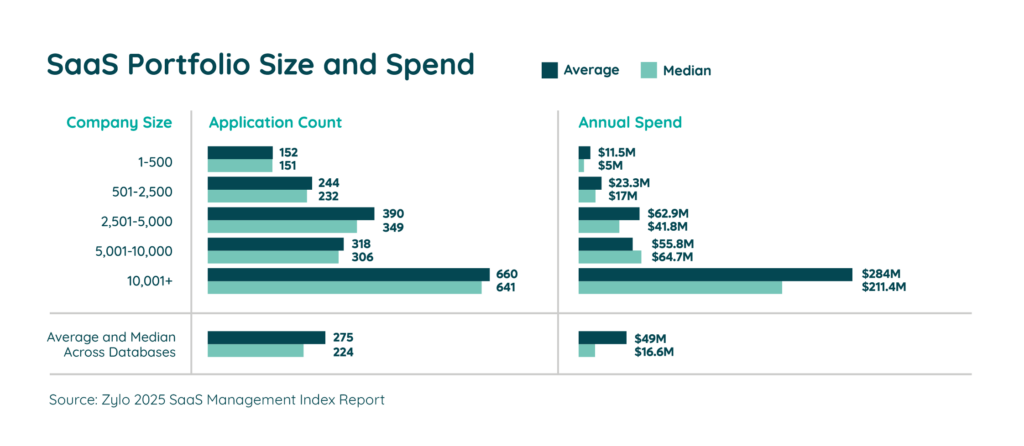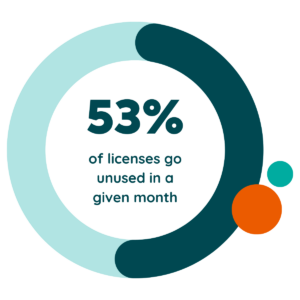Table of Contents
SaaS presents both an opportunity and a challenge for growing companies. On one hand, running with SaaS solutions means you add flexibility, fast functionality, and robust integrations to your tech stack. On the other hand, SaaS can quickly get out of control. Between adding and removing seats, tracking renewal dates, and IT losing control of which tools are used in the organization, the sprawl can lead to headaches—especially if you’re not proactively monitoring your SaaS usage metrics.
You can’t track everything manually in spreadsheets, of course. When it comes to SaaS Management, it’s important to understand which metrics to use to measure the effectiveness of your strategy. But remember that SaaS Management isn’t “one and done”—it’s an ongoing process that requires you to continually monitor and optimize your SaaS.
This article covers the most important SaaS usage metrics you should continually monitor, what those metrics may mean for your business, red flags to look out for, and indications it’s time to make a change in your SaaS tools.
Why SaaS Usage Metrics Matter More Than Ever
SaaS adoption has continued to grow across most departments. Though that growth usually improves productivity and collaboration, it also creates challenges. Keeping track of budgets, security, and software usage, for example, can be difficult. SaaS usage metrics provide organizations with the data they need to manage growth without losing visibility or control.
The right metrics help teams answer several important questions like:
- Are we using what we’re paying for?
- Are tools being adopted by the right people?
- Are we prepared for upcoming renewal dates?
Without clear and organized usage data, it’s hard to make smart decisions about contracts, onboarding practices, provisioning, or budgeting. That’s why usage metrics are now an essential component of any successful SaaS Management strategy.
The 4 Reporting Metrics SaaS Managers Should Care About Most
SaaS Management is about optimizing your tech stack by identifying duplicate solutions, reducing costs by assessing usage and, at the same time, ensuring your organization has access to the tools they need.
That’s a nearly impossible task without continually monitoring how your SaaS tools are being used—and how much they cost the company.
Consider what we’ve written previously on the topic: “Organizations that don’t constantly monitor their SaaS tech stacks are spending more by not getting discounted enterprise deals, have overlapping and often unnecessary technologies, see a spike in underutilized licenses, increase their security risks, and have a difficult time budgeting for future projections.”
Read More: Why It’s Important to Constantly Monitor Your SaaS Apps
There are plenty of benchmarks to consider, but we see four reporting metrics as particularly important for SaaS managers:
- Total SaaS spend
- Number of applications in use
- SaaS utilization by user or license
- Number of upcoming renewals
These 4 metrics are important to glean during SaaS discovery and will give you the “big picture” of your organization’s landscape. Not to mention, they’ll set you up for making more informed decisions.
Total SaaS Spend
The 2025 SaaS Management Index shows that the average company spends $49M annually on SaaS. Reporting on this metric regularly allows you to see trends and changes over time.
- Are you spending more or less?
- Is it in line with the budget you laid out at the beginning of the year?
- Are you happy with the amount you’re spending, or do you think you could optimize a bit more?
Finance and IT teams should focus on identifying unexpected increases in spend, tracking cost per user, and spotting tools that are expensed outside of approved processes. Reviewing total spending alongside headcount can help teams track scaling efficiently.
Number of Applications
Similar to total SaaS spend, tracking the number of applications used within your organization gives you a benchmark. Our data shows that the average organization has 275 apps but often underestimate that number by almost 2X.
When teams purchase software without approval or coordination with procurement, it results in a higher number of tools. This leads to tool sprawl and multiple apps that do the same job. Flagging these trends early gives IT and Procurement the chance to merge licenses and standardize platforms.

SaaS Utilization
On average, more than half of SaaS licenses are unused in a given month, despite the industry standard aiming for 90% utilization or higher. Without visibility into SaaS utilization, it’s impossible to know where license and cost optimization opportunities lie.

It starts with a simple question that may be difficult to answer without the right SaaS Management platform: how utilized are your applications? If your teams aren’t using tools you’re paying for, you’re wasting money.
For example, do you have underutilized (or unutilized) Zoom seats? Do your teams depend on one project management app but completely ignore a different one that somehow ended up in your stack?
License-level utilization tracks whether users are engaging meaningfully with an application, rather than just logging in occasionally. A user might access an app once a month, but if that license costs $100 per seat, the ROI likely isn’t there.
FinOps and Procurement teams can use this data to rightsize contracts before renewal and to compare costs across other tools that offer similar features.
Number of Renewals on the Horizon
According to Zylo’s SaaS Management Index, the average organization experiences 247 SaaS renewals a year, or nearly one per business day.
Keep track of when your company’s SaaS renewals are coming up so you can proactively manage them.
- Understand which SaaS tools are up for renewal in the next three months so you can prioritize your SaaS Management decisions.
- Avoid surprise renewals. Who hasn’t gotten an unexpected charge on their credit card for a trial or forgotten subscription?
- Get time to collect feedback, weigh your options and make an informed decision.
Before starting renewal discussions, prepare usage data in advance. This puts your organization in a stronger position to negotiate contract terms, request discounts, or switch to a more cost-effective licensing tier. Vendors are more likely to offer flexible pricing if you bring clear metrics to the table.
Role-by-Role: How Do SaaS Usage Metrics Drive Better Decisions?
Usage metrics help IT, Finance, and Procurement teams make faster, smarter decisions—no matter their goals.
For IT Leaders and Software Asset Management
SaaS usage metrics help IT leaders and Software Asset Management (SAM) teams monitor provisioning, support license positioning, and optimize license usage across the organization.
- IT focuses on enforcing policies and managing access
- SAM teams analyze usage data to maintain compliance, right-size solutions, and ensure software investments meet business needs
With clear and consistent metrics, these teams can more effectively enforce app standards, lessen security risks, and decommission unused tools. Usage data also supports rationalization efforts, especially when trying to reduce the overall tech stack without disrupting productivity.
For Finance and FinOps Teams
Finance and FinOps teams review SaaS metrics to understand:
- Understand cost-per-user
- Track trends in usage-based pricing models
- Forecast spend
- Stay on top of budget planning
This sort of visibility helps avoid surprises at renewal time and ensures the organization isn’t paying for licenses that employees won’t likely use.
For Procurement and Vendor Management
Usage metrics provide procurement teams leverage to negotiate favorable contract terms. They can back up requests for tier changes, volume discounts, or custom contracts by showing vendors exactly how the tool aligns with the company’s needs. This helps with both initial negotiations and long-term vendor management efforts.
Going Beyond Metrics: Turn Insights Into Action
SaaS usage metrics only really matter when you can act on them, and they have to make sense. Here are a few ways teams can further utilize their SaaS data:
- Cutting underused or inactive licenses before renewal.
- Flagging apps for consolidation when multiple teams use different tools for the same job.
- Negotiating user-based pricing with vendors who offer flexible contracts.
- Reharvesting unused licenses and reallocating them to new hires.
- Identifying users improperly offboarded to free up licenses for new users.
By monitoring usage metrics regularly, you can routinely identify new opportunities to optimize your stack.
3 Overlooked SaaS Usage Metrics That Can Save You Money
Tracking SaaS usage metrics like spend and utilization is a must, but some lesser-known metrics can uncover hidden savings opportunities. These metrics can provide deeper insights into your software’s value and improve the efficiency of your SaaS Management strategy.
- Feature-Level Usage
- Department-Level Usage Trends
- Application Overlap
Feature-Level Usage (Not Just Logins)
Knowing that a user logs in is useful, but knowing how they use the tool is even better. Feature-level usage helps identify whether users are accessing high-value parts of a product (if this data is available from your vendor). If they aren’t, you may be able to switch to a lower-cost tier or negotiate reduced functionality for a better price.
For example, if only a few of your team members are using premium features while others only access basic functionality, you could explore scaling down some licenses to save money.
Department-Level Usage Trends
Usage can vary widely from one team to another. Tracking app usage by department helps highlight adoption issues, training needs, or opportunities for standardization. It can also support financial processes like showbacks or chargebacks. This kind of visibility is useful when determining whether a tool should be expanded to other departments or cut from the tech stack entirely.
If a department isn’t using a specific application as expected, it might signal that a different tool is more suitable for their needs, or perhaps that additional training is necessary.
Application Overlap
Many companies use multiple apps that do the same job, like having five different tools for project management or three platforms for video conferencing. Tracking overlap allows Procurement and IT teams to recommend consolidation or simplify support and training processes.
This metric can help identify cost-saving opportunities by eliminating redundant apps. Consolidating tools and unifying platforms allows your organization to cut down complexity and improve workflows.
Final Thoughts: SaaS Metrics Aren’t Just for Reports, They’re for Action
Keeping track of SaaS usage metrics is just the first step. Real impact comes from turning that data into results. When it comes to cutting costs, reducing risk, or driving adoption, usage insights provide a fast path to smarter decisions.
When teams have clear visibility into how software is actually used, they can align spending with value, boost productivity, and uncover hidden inefficiencies. A continuous loop of tracking, analysis, and action keeps your SaaS stack supportive, effective, and ready to scale.
Trust Zylo for Centralizing Your SaaS Usage Metrics
Zylo’s SaaS Management platform is built to surface these insights and make them actionable. From license optimization to renewal planning, Zylo helps organizations make the most of every SaaS dollar.
Get full visibility into your SaaS. Schedule a demo today to see how Zylo can help you better monitor and manage SaaS for your business.

